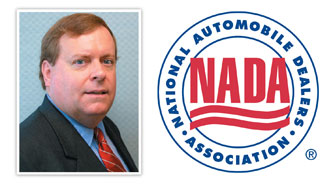NADA: Used Market Helping to Spur New-Car Growth

McLEAN, Va. –
New-vehicle sales showed some vibrancy in November, and the coming months are likely to be robust, as well, the National Automobile Dealers Association’s chief economist Paul Taylor said Thursday.
The state of the used-vehicle market is one of the factors helping the new-car sales strength, he added.
While mentioning other economic elements such as aging U.S. fleets and stock market gains, Taylor discussed the impact the used-car market has had on the new side.
Citing data from NADA Guides, Taylor indicated that some consumers are turning to new vehicles due in large part to the spike in used-car prices.
“The used-vehicle market will remain short of low-mileage cars and trucks, which for car owners will increase their trade-in equity when buying a new vehicle,” Taylor explained. “This is another key economic factor that will sustain new-vehicle sales increases in future months.”
Moving on, he also pointed out that the average vehicle driven is generally older than 10 years, which means a large portion of shoppers may be looking to replace their ride.
“Many consumers simply will feel the need to buy a new car or truck as the mileage on their current vehicles moves beyond the 120,000-miles mark,” Taylor suggested.
He went on to say that the relatively robust stock market has been helping along new sales in the luxury segment to a climb of about 21 percent.
Truck segments were also quite strong in November, as well. Taylor reported a 21-percent year-over-year uptick in large pickup sales and a 17-percent gain for SUVs. Meanwhile, CUV sales showed a 25-percent improvement.
Through the year’s first 11 months, CUV sales climbed 23 percent, with large pickups showing a 19-percent gain. The SUV segment displayed a 12-percent gain.
The CUV segment commanded more than a 27-percent share of the U.S. new-vehicle market during November. The Chevrolet Equinox, Ford Escape, Honda CR-V and Toyota RAV4 were among the best-sellers, Taylor noted.
Wrapping up the analysis, the economist explained: “Today’s new-vehicle market remains largely about the ‘needs’ of consumers, while it was about the ‘wants’ of consumers during the boom years of 2002 through 2007.
“An improving outlook for employment and rising consumer confidence will help sustain real GDP growth of more than 2.5 percent for the second half of 2010,” he concluded.
Subscribe to receive our daily e-newsletter and never miss the latest industry news, trends, and insights across the used-car and remarketing space.


